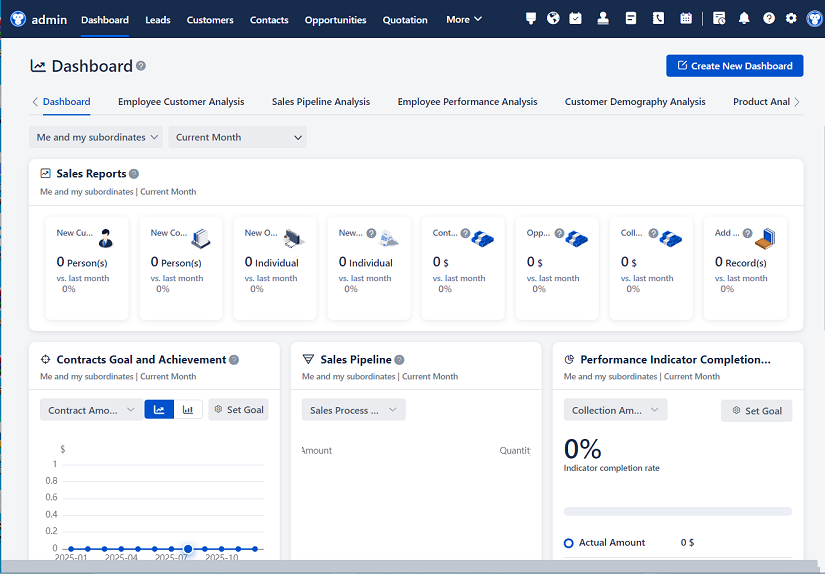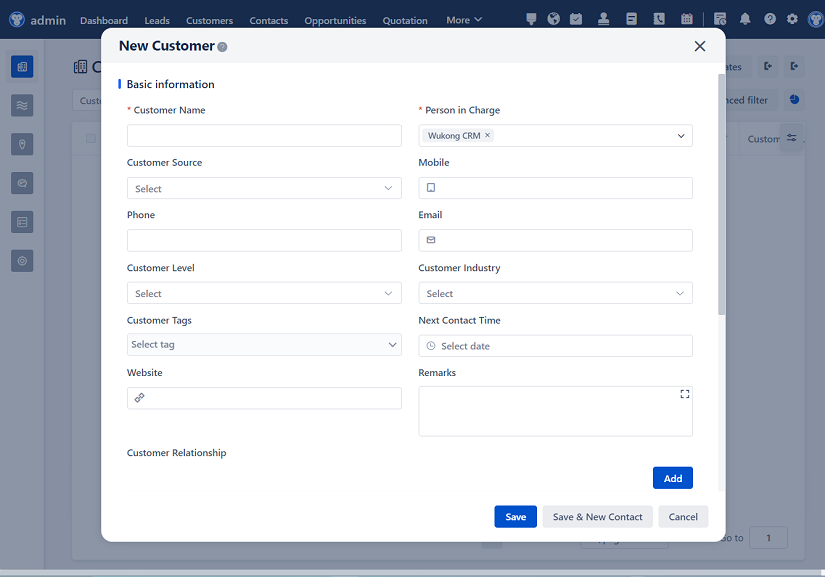
△Click on the top right corner to try Wukong CRM for free
Hey there! So, you're interested in CRM data table design, huh? That's a pretty cool topic, and I'm glad you asked. Let's dive right into it, shall I?

First things are first, when we talk about CRM, or Customer Relationship Management, we’re really talking about how businesses keep track of all the interactions they have with their customers. It’s like having a super organized address book, but way more powerful. Now, imagine if that address book could also tell you what your customers like, what they’ve bought, and even predict what they might want next. That’s kind of what a good CRM system does.
But, to make all of this magic happen, you need a solid foundation, and that’s where the data table design comes in. Think of it as the blueprint for your CRM house. If the blueprint is off, well, you can imagine the mess that would create, right? So, let’s get into the nitty-gritty of designing these tables.
When you start thinking about your CRM data tables, the first thing you should do is sit down and really think about what information you need to store. It’s like planning a trip; you wouldn’t just pack random stuff, would you? No, you’d think about where you’re going, what you’ll be doing, and then pack accordingly. The same goes for your CRM. You need to know what kind of data you’re dealing with, and that means understanding your business processes inside out.

Now, one of the most important tables in any CRM system is the customer table. This is where you store all the basic information about your customers, like their names, contact details, and maybe even some personal preferences. It’s like having a little profile card for each person. But, here’s the thing: you don’t want to overdo it. Just because you can store every single detail doesn’t mean you should. Keep it simple and only include what’s really necessary. Otherwise, you’ll end up with a cluttered, hard-to-manage database, and nobody wants that, do they?
Another key table is the interaction table. This is where you log all the touchpoints you have with your customers, whether it’s an email, a phone call, or a face-to-face meeting. It’s like keeping a diary of all your conversations, but in a structured way. This table is super important because it helps you understand the history of your relationship with each customer. And, trust me, knowing that history can be a game-changer when it comes to providing great service.
Of course, no CRM system would be complete without a sales table. This is where you track all the deals, opportunities, and orders. It’s like having a scoreboard for your business. You can see at a glance how many deals are in the pipeline, which ones are close to closing, and which ones might need a little extra attention. This table is crucial for your sales team, as it helps them stay on top of their game and prioritize their efforts.

Now, let’s talk about relationships. In the world of databases, relationships aren’t just about being friendly; they’re about connecting different tables in a meaningful way. For example, you might have a customer table and a sales table, and you want to link them so you can see which customer is associated with which sale. This is done using something called foreign keys, which are like little bridges between tables. They help you keep everything connected and make sure your data stays consistent.
Speaking of consistency, that brings us to another important aspect of CRM data table design: normalization. Normalization is a fancy word for organizing your data in a way that minimizes redundancy and ensures that everything is stored in the most efficient way possible. It’s like decluttering your closet. You don’t want to have the same shirt in three different places, right? The same goes for your data. By normalizing your tables, you avoid duplication and make your database much easier to manage.
But, here’s the catch: sometimes, too much normalization can be a bad thing. It can make your queries slower and more complex. So, you need to find a balance. It’s like cooking a meal; you want to add just the right amount of seasoning, not too much and not too little. The same principle applies to your CRM data tables. You want to normalize enough to keep things tidy, but not so much that you sacrifice performance.
Another thing to consider is scalability. As your business grows, so will your CRM. You need to design your tables in a way that can handle more data, more users, and more complexity. It’s like building a house; you want to make sure it has a strong foundation and room to expand. This means thinking about things like indexing, partitioning, and even sharding. These are all techniques that help your database perform better as it gets bigger.

And, while we’re on the topic of performance, let’s talk about indexes. Indexes are like the yellow pages for your database. They help you find the data you need quickly and efficiently. Without indexes, searching through a large database can be painfully slow. So, make sure you index the columns that you frequently search on, like customer IDs or order dates. But, again, don’t go overboard. Too many indexes can slow down your write operations, so use them wisely.
Now, let’s talk about security. Your CRM data is probably some of the most sensitive information your company has, so you need to protect it. This means setting up proper access controls, encrypting sensitive data, and making sure you have backups in case something goes wrong. It’s like locking your front door and setting up a security system for your home. You want to make sure that only the right people can get in, and that your data is safe from prying eyes.

Finally, let’s not forget about maintenance. A well-designed CRM data table is only as good as the care you put into it. This means regularly cleaning up old data, checking for inconsistencies, and making sure everything is running smoothly. It’s like taking your car in for regular check-ups. You want to catch any issues early before they become big problems.
So, there you have it! That’s a quick rundown of CRM data table design. It’s a lot to take in, I know, but it’s worth it. A well-designed CRM can be a game-changer for your business, helping you build stronger relationships with your customers and drive growth.
Alright, now that we’ve covered the basics, let’s wrap things up with a few questions and answers. Sound good?
Q: What is the most important table in a CRM system? A: The customer table is often considered the most important because it stores all the basic information about your customers, which is the foundation for all other interactions and data in the CRM.
Q: Why is normalization important in CRM data table design? A: Normalization helps minimize data redundancy and ensures that your data is stored in the most efficient way possible. This makes your database easier to manage and reduces the risk of inconsistencies.
Q: How can I ensure my CRM data is secure? A: To ensure your CRM data is secure, set up proper access controls, encrypt sensitive data, and make sure you have regular backups. Regularly review and update your security measures to stay ahead of potential threats.
Q: What role do indexes play in CRM data table design? A: Indexes help speed up data retrieval by allowing the database to quickly locate the data you need. They are especially useful for frequently searched columns, but be careful not to over-index, as this can slow down write operations.

Q: How can I make sure my CRM data tables are scalable? A: To ensure scalability, design your tables with future growth in mind. Use techniques like indexing, partitioning, and sharding to improve performance as your data and user base grow. Regularly review and optimize your database structure to handle increased load.

I hope this helps! If you have any more questions, feel free to ask. Happy designing!
Related links:
Free trial of CRM
Understand CRM system
AI CRM Systems

△Click on the top right corner to try Wukong CRM for free